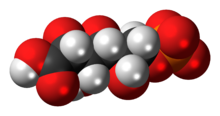This is the current revision of this page, as edited by Spacemarine10 (talk | contribs) at 07:01, 11 May 2024. The present address (URL) is a permanent link to this version.
Revision as of 07:01, 11 May 2024 by Spacemarine10 (talk | contribs)(diff) ← Previous revision | Latest revision (diff) | Newer revision → (diff)
| |

| |
| Names | |
|---|---|
| IUPAC name 6-O-Phosphono-D-gluconic acid | |
| Systematic IUPAC name (2R,3S,4R,5R)-2,3,4,5-Tetrahydroxy-6-(phosphonooxy)hexanoic acid | |
| Other names 6-Phosphogluconate | |
| Identifiers | |
| CAS Number | |
| 3D model (JSmol) | |
| ChEBI | |
| ChemSpider | |
| ECHA InfoCard | 100.011.882 |
| MeSH | 6-phosphogluconate |
| PubChem CID | |
| UNII | |
| CompTox Dashboard (EPA) | |
InChI
| |
SMILES
| |
| Properties | |
| Chemical formula | C6H13O10P |
| Molar mass | 276.135 g/mol |
| Except where otherwise noted, data are given for materials in their standard state (at 25 °C , 100 kPa).
| |
6-Phosphogluconic acid (with conjugate base 6-phosphogluconate) is a phosphorylated sugar acid which appears in the pentose phosphate pathway and the Entner–Doudoroff pathway.
During the oxidative phase of the pentose phosphate pathway, it is formed from 6-phosphogluconolactone by 6-phosphogluconolactonase, and in turn, it is converted to ribulose 5-phosphate by phosphogluconate dehydrogenase, in an oxidative decarboxylation which also produces NADPH.
In those microorganisms which host the Entner-Doudoroff pathway, 6-phosphogluconic acid may also be acted upon by 6-phosphogluconate dehydratase to produce 2-keto-3-deoxy-6-phosphogluconate.
| Pentose phosphate pathway metabolic intermediates | |
|---|---|
| Oxidative | |
| Nonoxidative | |
This biochemistry article is a stub. You can help Misplaced Pages by expanding it. |